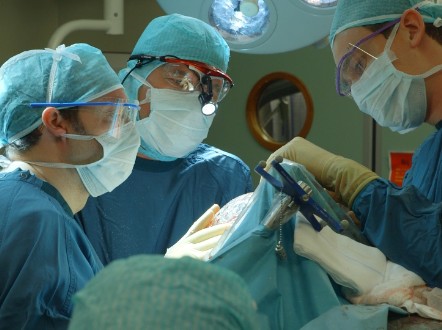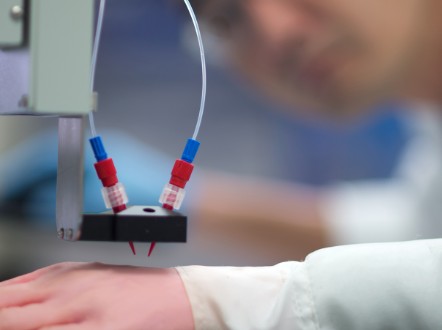/ News

Artificial eyes, plastic skulls: 3-D printing the human body
The 21st century has seen the growth of 3-D printing, with well-known applications in architecture, manufacturing, engineering, and now increasingly in medicine.
The birth of 3-D scanning technologies combined with organic inks and thermoplastics has enabled the "bioprinting" of a range of human body parts to accommodate a wide range of medical conditions. Let's start form the top.
Skulls
Doctors at University Medical Center Utrecht, in Holland, have reported successfully performing the first surgery to completely replace a patient's skull with a tailor-made plastic version that was 3-D printed.
The patient had a chronic bone disorder that caused her skull to be 5cm thick. The hospital said the condition had caused her to lose her vision and ultimately would have killed her, but that three months after the operation the patient regained her vision and was able to return to work.

Doctors at University Medical Center Utrecht implant a printed plastic skull
Eyes
Batch-printing of up to 150 prosthetic eyes an hour has become a reality according to UK-based company Fripp Design and Research. The mass-production technique promises to speed up the manufacture of eye prostheses and drive down the cost. Printing each eye with slight variation in color is intended to produce better aesthetic results.
The aim is to ensure more affordable eyes for the developing world with countries such as India reportedly showing interest in the products. The company, in collaboration with the UK's Manchester Metropolitan University, hopes to implement the use of its printed eyes within the next year.
Noses and Ears
Fripp Design has also collaborated with the University of Sheffield, in the United Kingdom, to produce facial prostheses such as ears and noses. 3-D facial scans of patients are used to print out prosthetics using pigments, starch powder and silicone for replica facial parts closely matching the patient's original nose or ear. The real benefit here is that once parts begin to wear, they can be re-ordered at a fraction of the cost as the technology and design will already be in place. The simpler process of scanning a patient's face, rather than more invasive face molds needed for traditional prostheses, also makes the process a lot more patient-friendly.
A team at Cornell University, in the United States, is doing things differently. It's printing 3-D molds of a patient's ear using ink gels containing living cells. The printed products are injected with bovine cartilage cells and rat collagen and incubated until they are ready three months later. Human transplants could be possible within three years, say researchers.
Read: Carpenter cuts off fingers, prints new ones
Synthetic Skin
James Yoo at the Wake Forest School of Medicine in the United States is developing a printer that will print skin straight onto the wounds of burn victims. The "ink" they're using consists of enzymes and collagen which once printed are layered with tissue cells and skin cells which combine to form the skin graft. The team plans on developing portable machines to print skin directly onto wounds in remote and war-torn settings.
The ideal synthetic skin graft needs to match the coloration of the patient as accurately as possible in order for the graft to look natural. Dr. Sophie Wuerger and her team at the University of Liverpool in the UK are working on using 3-D cameras, image processing and skin modeling to ensure the tone and texture of printed skin match up to the real thing.

Researching skin transplants on a fake hand, at Wake Forest School of Medicine.
Limbs
Thermoplastics have led the way in the growth of printable hands, arms and even individual fingers. Richard Van As is one of those producing affordable hand and finger prostheses with his company Robohand, based in South Africa. The team is creating functional fingers for use on amputated hands by combining the printing of the thermoplastic polylactide with aluminum and stainless steel digits to create a functioning mechanical finger.
Robohand recently collaborated with U.S. entrepreneur Mike Ebeling on a project providing affordable printed arms to war amputees in Sudan. The collaboration is known as "Project Daniel," named after 14 year-old Daniel Omar who lost both his hands and part of his arms after a bomb was dropped near his family home in Sudan's Nuba mountains. The team is enabling Robohands to reach the masses at costs as small as $100 for a basic hand.
Bones
One of the more established fields of 3-D printing is the bioprinting of human bone implants, and now replacement bones.
In 2011, researchers at Washington State University announced they had printed a bone-like structure that acts as a scaffold for new bone cells to grow on, before it degrades. The structure was printed using calcium phosphate and has been successfully tested in animals. The hope is to print customized grafts for use in patients with bone fractures.
Read: 3-D printed arm gives hope to boy maimed by bomb
Read: Robot exoskeleton lets girl lift her arms
Read: Lungs on a chip and 3-D printed hearts
Source: http://edition.cnn.com/2014/04/17/tech/innovation/artificial-eyes-3d-printing-body/
/ About us
Founded by Russian entrepreneur Dmitry Itskov in February 2011 with the participation of leading Russian specialists in the field of neural interfaces, robotics, artificial organs and systems.
The main goals of the 2045 Initiative: the creation and realization of a new strategy for the development of humanity which meets global civilization challenges; the creation of optimale conditions promoting the spiritual enlightenment of humanity; and the realization of a new futuristic reality based on 5 principles: high spirituality, high culture, high ethics, high science and high technologies.
The main science mega-project of the 2045 Initiative aims to create technologies enabling the transfer of a individual’s personality to a more advanced non-biological carrier, and extending life, including to the point of immortality. We devote particular attention to enabling the fullest possible dialogue between the world’s major spiritual traditions, science and society.
A large-scale transformation of humanity, comparable to some of the major spiritual and sci-tech revolutions in history, will require a new strategy. We believe this to be necessary to overcome existing crises, which threaten our planetary habitat and the continued existence of humanity as a species. With the 2045 Initiative, we hope to realize a new strategy for humanity's development, and in so doing, create a more productive, fulfilling, and satisfying future.
The "2045" team is working towards creating an international research center where leading scientists will be engaged in research and development in the fields of anthropomorphic robotics, living systems modeling and brain and consciousness modeling with the goal of transferring one’s individual consciousness to an artificial carrier and achieving cybernetic immortality.
An annual congress "The Global Future 2045" is organized by the Initiative to give platform for discussing mankind's evolutionary strategy based on technologies of cybernetic immortality as well as the possible impact of such technologies on global society, politics and economies of the future.
Future prospects of "2045" Initiative for society
2015-2020
The emergence and widespread use of affordable android "avatars" controlled by a "brain-computer" interface. Coupled with related technologies “avatars’ will give people a number of new features: ability to work in dangerous environments, perform rescue operations, travel in extreme situations etc.
Avatar components will be used in medicine for the rehabilitation of fully or partially disabled patients giving them prosthetic limbs or recover lost senses.
2020-2025
Creation of an autonomous life-support system for the human brain linked to a robot, ‘avatar’, will save people whose body is completely worn out or irreversibly damaged. Any patient with an intact brain will be able to return to a fully functioning bodily life. Such technologies will greatly enlarge the possibility of hybrid bio-electronic devices, thus creating a new IT revolution and will make all kinds of superimpositions of electronic and biological systems possible.
2030-2035
Creation of a computer model of the brain and human consciousness with the subsequent development of means to transfer individual consciousness onto an artificial carrier. This development will profoundly change the world, it will not only give everyone the possibility of cybernetic immortality but will also create a friendly artificial intelligence, expand human capabilities and provide opportunities for ordinary people to restore or modify their own brain multiple times. The final result at this stage can be a real revolution in the understanding of human nature that will completely change the human and technical prospects for humanity.
2045
This is the time when substance-independent minds will receive new bodies with capacities far exceeding those of ordinary humans. A new era for humanity will arrive! Changes will occur in all spheres of human activity – energy generation, transportation, politics, medicine, psychology, sciences, and so on.
Today it is hard to imagine a future when bodies consisting of nanorobots will become affordable and capable of taking any form. It is also hard to imagine body holograms featuring controlled matter. One thing is clear however: humanity, for the first time in its history, will make a fully managed evolutionary transition and eventually become a new species. Moreover, prerequisites for a large-scale expansion into outer space will be created as well.
Key elements of the project in the future
• International social movement
• social network immortal.me
• charitable foundation "Global Future 2045" (Foundation 2045)
• scientific research centre "Immortality"
• business incubator
• University of "Immortality"
• annual award for contribution to the realization of the project of "Immortality”.



 LinkedIn
LinkedIn
 LiveJournal
LiveJournal
 Google
Google
 Twitter
Twitter
 Facebook
Facebook
 Я.ру
Я.ру
 ВКонтакте
ВКонтакте
 Mail.ru
Mail.ru